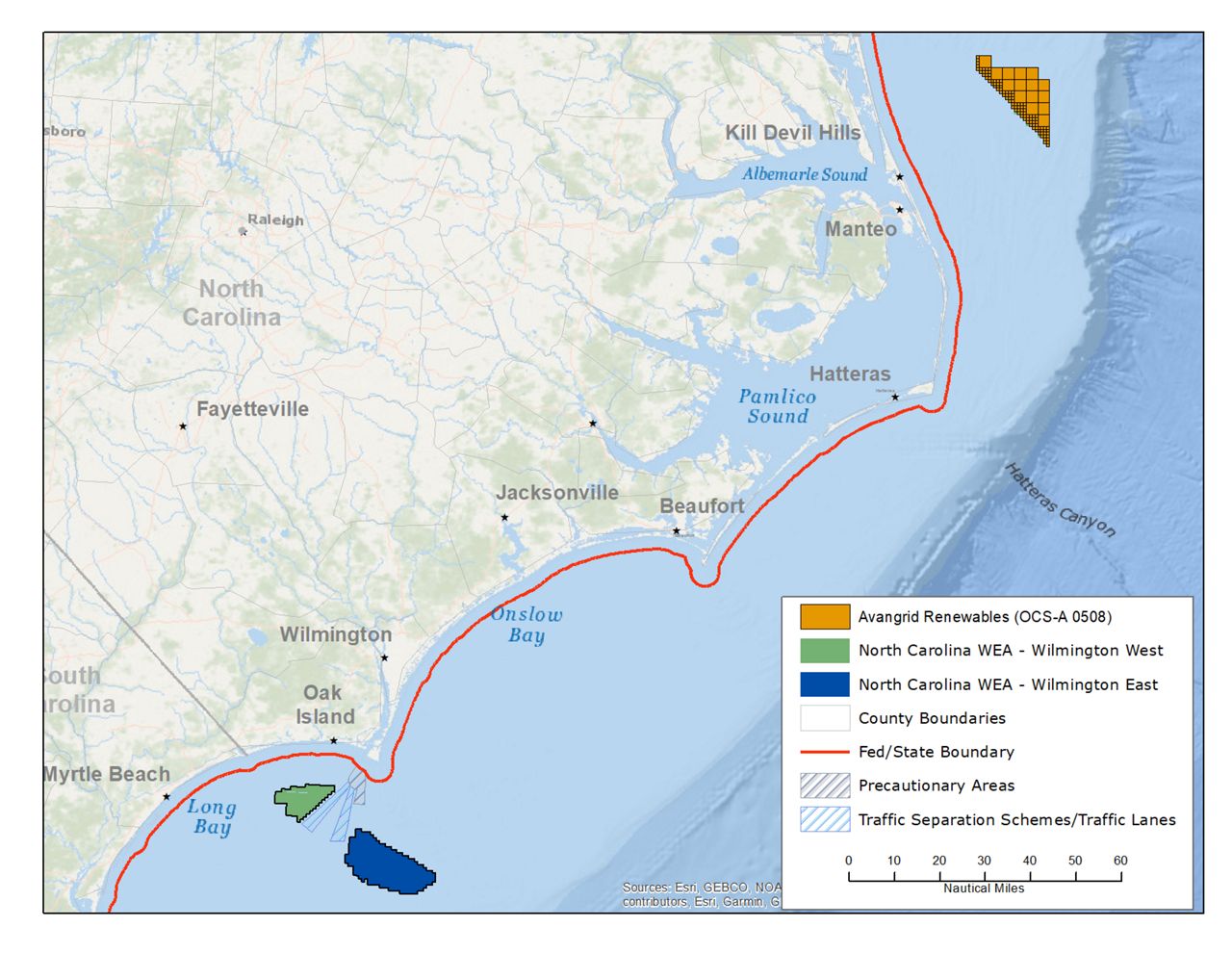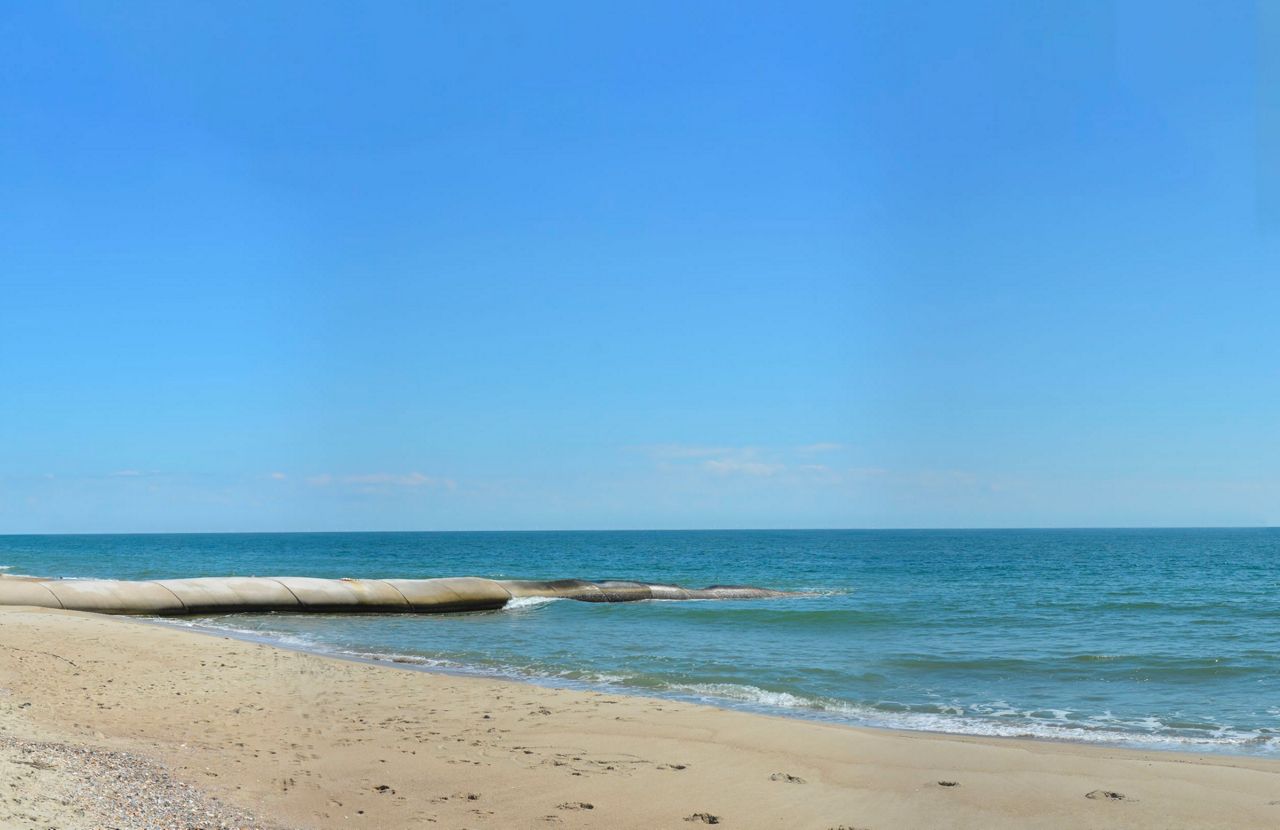The images, at first glance, look like photographs of the beach and the ocean taken from three beaches in Brunswick County, just south of Wilmington. But leaning in close, there’s something else on the horizon.
On a clear day, the Wilmington East offshore wind farm would be barely visible from the beach. The photos show the wind turbines peaking over the horizon. Even if they remembered their glasses, people had to lean in close to actually see the turbines.
“The takeaway is that you’re not going to be able to see this project unless you are at one of the closer beaches, which might be Bald Head Island, and really trying to look for it,” said Katharine Kollins, president of the Southeastern Wind Coalition. “On an average day, it really just blends in with the water and the horizon.”
The Southeast Wind Coalition commissioned the images, which use imagery from the Bureau of Ocean Energy Management and made by UNASYS, a British company that works on large-scale energy and industrial projects.
“What we are doing here today is trying to give folks on the coast a realistic expectation of what a full buildout of the Wilmington East Wind Energy Area would look like,” Kollins said.

Kollins’ group and Offshore Wind for North Carolina brought the images to Southport last week, where about 100 community members came to see just what this wind farm would look like from the beach.
Some in the community oppose the offshore wind farm, concerned about impacts on the environment, fishing and the view from the beach.
The Wilmington East Wind Energy Area could go up for lease later this year. At the closest to land, the area is about 17 nautical miles off Bald Head Island, then extends about 18 nautical miles to the southeast.
The lease area is almost 128,000 acres and has the potential to generate more than 1.5 gigawatts of electricity, according to the Bureau of Ocean Energy Management. To put that in perspective, an average nuclear power plant generates 1 gigawatt.
The wind energy lease off the southeastern coast of North Carolina could power more than 500,000 homes.
The turbines might look like specks on the horizon, but up close, they are massive. The visualizations assume the project will use GE turbines that produce 13 megawatts each. The turbines will tower more than 850 feet above the ocean. The blades are each 722 feet long, as long as two football fields.
Offshore wind farms take decades to develop. With a lease sale expected later this year, it would still take several years to finish environmental studies, do the engineering work and actually build the wind farm.
“We’re talking about a 2,400 to 2,500 megawatt project, which would be feasible around the 2030 timeframe,” she said. A project that size would involve more than 180 wind turbines off the coast.
A separate project on the North Carolina coast, off the northern Outer Banks, is further along in the process. The Bureau of Ocean Energy Management leased the Kitty Hawk Offshore Wind Energy Area to Avengrid Renewables in 2017.
The Kitty Hawk site is 27 miles off the coast from Corolla. The company expects to start building turbines off the Outer Banks in 2026.
Avengrid has not officially signed a deal with a power company for that electricity, but it’s likely it will go to Dominion Energy in Virginia.

Talking about the Wilmington project, Kollins said one of the top questions is about where the power will go.
She said she was surprised how much she heard that question while in Southport Friday.
“I think that there’s a great possibility that we can get the electricity from a Wilmington East project into North Carolina. It requires cooperation from the utilities, from the legislature, from the Utilities Commission, certainly all of which can be influenced by North Carolinians,” Kollins said.
Last year, North Carolina Gov. Roy Cooper signed an executive order setting a goal of generating 2.8 gigawatts of energy from offshore wind by the end of this decade and 8 gigawatts by 2040.
In North Carolina, and up and down the eastern seaboard, offshore wind means more than clean energy. It will mean big business for coastal communities, with building new manufacturing facilities for the giant components, construction of the wind farms at sea, and maintenance and upkeep for decades into the future.
“We’re talking about bringing a supply chain that currently exists in Europe and Asia to the U.S.,” Kollins said.
Just to the north, in Hampton Roads, Virginia, Spanish company Siemens Gamesa is building the first plant in the United States to make massive offshore wind turbine blades.
The components of these turbines are so large, they need to be made on the coast so they can be put directly on ships to be taken out to sea.
A new study from the Southeast Wind Coalition estimates that just the Wilmington East project alone will bring up to $4.6 billion in economic benefit to North Carolina.
The report estimates the project could create 31,000 full-time jobs during construction and more than 900 jobs long-term for upkeep and operations on the wind farm.
“The single largest contributing factor to realizing supply chain investment so far has been a state indicating a firm commitment to procuring the electricity from the projects being built off its coast,” said Jaime Simmons, with the Southeast Wind Coalition.
“The economic opportunity is massive, but North Carolina needs to solidify its commitment to offshore wind in order to capture the greatest benefit possible,” she said when the report was released earlier this year.








)
